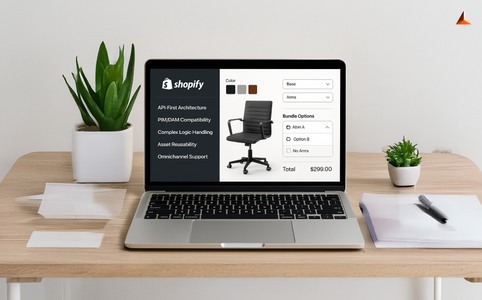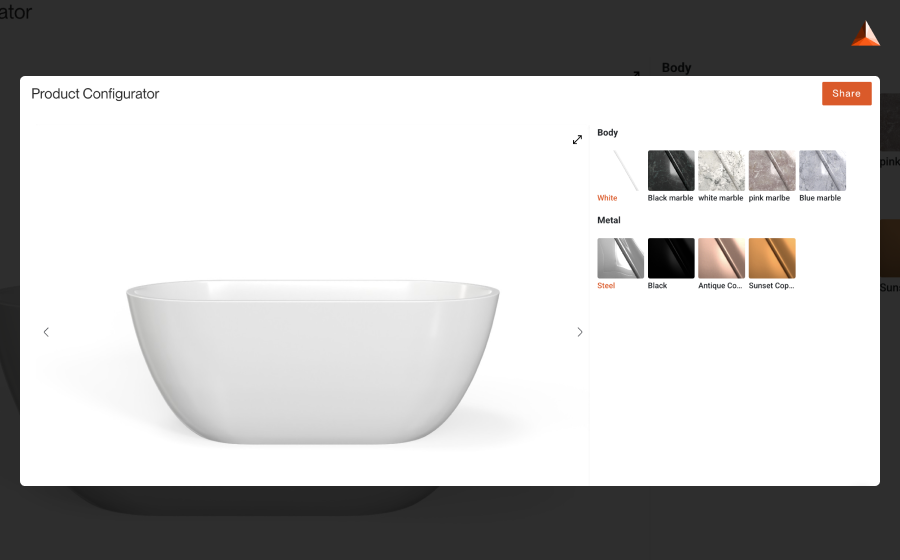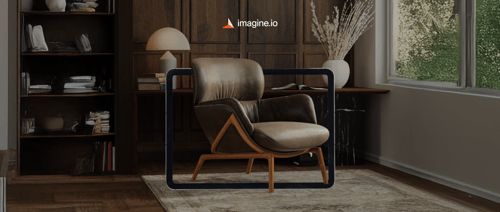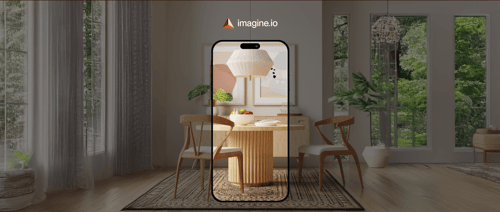If you run a Shopify store, you already know Shopify does a lot out of the box—variants, dropdown menus, and product image galleries. But here’s the problem: Shopify’s native setup quickly runs into limitations. If you sell configurable or customizable products, you’ve probably seen issues like limited variant combinations, poor visualization, clunky dropdowns, and manual errors.
That’s where a Shopify product configurator comes in. Instead of being locked into Shopify’s default system, a configurator gives you a visual, rule-driven, and scalable way to let customers personalize products—while keeping your backend clean and accurate.
In this guide, I’ll walk you through what Shopify’s default setup lacks, why third-party configurators solve those gaps, and how to choose the best Shopify product configurator for your store.
Get the latest updates straight to your inbox.
By clicking sign up you'll receive occasional emails from imagine.io. You always have the choice to unsubscribe within every email you receive.
Why Shopify’s Default Variants Aren’t Enough
Shopify gives you up to 100 variants per product. That sounds flexible—until you try managing complex catalogs.
-
Limited Variant Counts
Shopify traditionally restricts products to a maximum of 3 options (e.g., size, color, material) and up to 100 variants per product. This quickly becomes crippling for highly customizable products—like furniture with different fabrics, sizes, colors, plus modular add-ons—where possible combinations easily exceed these limits.
-
Lack of Real-Time Visualization
In Shopify’s default variant setup, customers typically choose from text labels (and possibly a single image per variant). This means they can’t see the exact outcome of their selected combination live—no dynamic preview, no 3D model, no layered live rendering.
-
High Manual Overhead & Error Risk
The more variants you manage, the higher the administrative complexity: double-checking pricing, stock levels, and SKUs. It’s far too easy for human errors to slip in—wrong prices, mismatched inventory, outdated info—especially when variant lists become bloated.
-
Hard to Scale
As variant complexity grows, product pages can become long, messy, and slow to load. This clutter makes backend management harder and diminishes performance, negatively impacting both merchant workflow and customer experience.
This is the gap a visual Shopify configurator fills.
Why Add a Shopify Product Configurator?

-
Front-End Value (Customer Experience)
Customers can see their product update in real time—colors, engravings, materials. With 3D and AR, they rotate, zoom, and even place products in their space. This isn’t just nice-to-have—it’s the difference between guessing and buying.
-
Back-End Value (Operational Efficiency)
Unlike static variants, a configurator uses rule-based logic.
- It integrates with Shopify’s pricing and inventory so only valid combinations are available.
- Pricing updates dynamically.
- Final orders push into Shopify clean—no manual intervention needed.
The result? A smooth front-end experience without breaking your backend setup.
Why It’s Worth the Cost of Third-Party Tech
Here are some core reasons why investing in advanced configurator solutions pays off—driving sales, reducing costly errors, and streamlining operations far beyond what native platforms can achieve.
-
Higher Conversions → Visual clarity reduces hesitation
Interactive 3D views eliminate uncertainty by showing customers exactly what they’ll receive. This transparency builds confidence, reduces decision friction, and directly improves conversion rates compared to static product images.
-
Lower Return Rates → Customers already “preview” the final product
When shoppers configure and preview products in detail—colors, finishes, or dimensions—they know precisely what to expect. This accuracy lowers buyer’s remorse and significantly reduces costly return rates.
-
Increased Average Order Value (AOV) → Visual upsells feel natural
Premium upgrades sell better when customers see them in real time. A configurator subtly presents finishes, add-ons, and variants, making upsells intuitive and naturally increasing average order value.
-
Operational Savings → Simpler backend, faster fulfillment
Third-party configurators streamline complexity with rule-based logic, eliminating invalid variants and manual errors. Orders flow cleaner through fulfillment, saving time, reducing administrative overhead, and improving overall operational efficiency.
Must-Have Features in the Best Shopify Configurator
|
Feature |
Why It Matters |
|
High-Quality 3D Visualization |
Delivers photorealistic textures, lighting, and detail—far beyond flat images. Builds buyer confidence and reduces returns. |
|
Real-Time Updates Without Lag |
Configurations should refresh instantly so customers don’t drop off due to delays. |
|
Mobile Optimization |
With 70%+ of Shopify traffic coming from mobile, configurators must load fast and perform smoothly on smaller screens. |
|
Rule-Based Logic |
Prevents impossible, invalid, or out-of-stock combinations—keeping the shopping experience frustration-free. |
|
Augmented Reality Integration |
Allows customers to preview products in their real-world space, boosting purchase confidence. |
|
Dynamic Pricing |
Updates prices automatically as customers add features or upgrades—transparent and great for upselling. |
|
Backend Integration |
Syncs with Shopify’s product, variant, and inventory data; supports fulfillment workflows; and scales seamlessly as your catalog grows. |
How to Choose the Best Product Configurator for Shopify

When you’re evaluating tools, don’t just think about visuals. Think about your entire Shopify stack. Ask:
- Integration: Does it plug into Shopify’s backend cleanly?
- Performance: Does it load fast on desktop & mobile?
- Ease of Use: Is it intuitive for both customers and your internal team?
- Scalability: Will it keep up as your catalog expands?
- Support: Is the provider reliable for updates & troubleshooting?
Why imagine.io is a Strong Choice for Shopify Configurators

While many tools claim to be the best product configurator for Shopify, imagine.io stands out for its fast-loading, photorealistic 3D visuals, AR capabilities, and easy Shopify integration
- Fast-loading, photorealistic 3D & AR visualization
- Rule-based configuration that keeps your backend clean
- Scalable setup without code-heavy workarounds
- Easy deployment into Shopify’s ecosystem
For Shopify site owners who need both customer-facing clarity and backend efficiency, imagine.io delivers both.
Conclusion: Make Your Shopify Store Stand Out
Shopify’s default variants were never designed for today’s personalization-driven shoppers. To scale, you need a configurator that integrates seamlessly with Shopify, improves customer confidence, and reduces backend complexity.
With the right tool—like imagine.io—you’re not just adding visuals; you’re creating a configurable commerce engine that grows with your business. Ready to see how it works? Activate your free trial today.
.png?width=1440&name=Best%20Shopify%20Product%20Configurator_%20How%20to%20Choose%20the%20Right%20One%20(2).png)

.gif?width=1296&height=1296&name=Untitled%20design%20(8).gif)




.png?width=500&name=How%20to%20Add%20a%203D%20Product%20Configurator%20to%20Your%20WordPress%20Website%20(Complete%20B2B%20Guide).png)
















%20(1).png?width=500&name=Why%20Exploded%20Mattress%20Views%20Matter%20(And%20How%20to%20Generate%20Them)%20(1).png)
.png?width=500&name=Best%20Shopify%20Product%20Configurator_%20How%20to%20Choose%20the%20Right%20One%20(2).png)
.png?width=500&name=Why%20Exploded%20Mattress%20Views%20Matter%20(And%20How%20to%20Generate%20Them).png)



.png?width=500&name=Best%20Shopify%20Product%20Configurator_%20How%20to%20Choose%20the%20Right%20One%20(1).png)







.png?width=500&name=How%203D%20Rendering%20Can%20Make%20or%20Break%20Your%20Industrial%20Design%20Pitch%20(1).png)








%20with%20Digital%20Twins%20and%203D%20Visualization.png?width=500&name=Optimizing%20Your%20Digital%20Asset%20Management%20(DAM)%20with%20Digital%20Twins%20and%203D%20Visualization.png)




.png?width=500&name=Styling%20Home%20Decor%20for%202025_%20From%20Global%20Influences%20to%20Playful%20Personalization%20(1).png)
